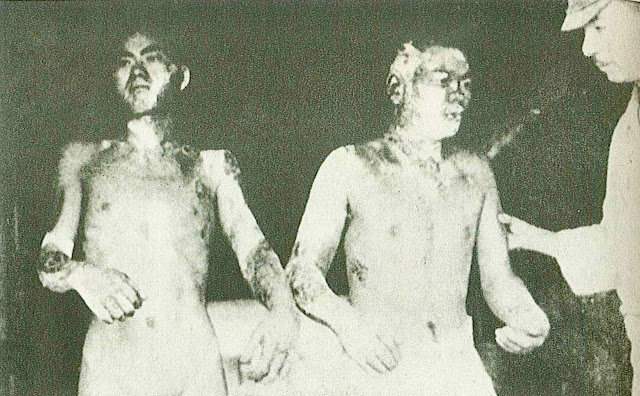Burns caused by atomic bombs developed only on the parts of the body that directly faced the flash of light emitted during the explosion. Depending on the posture, direction, and position of the victim at the time of the bombing, the burn surface faced the hypocenter where the Hiroshima atomic bomb exploded. The A-bomb survivors were escorted to the Army's Ninoshima Island Quarantine Station on Ninoshima Island, about 3 km offshore from Hiroshima Bay. Immediately after the explosion of the Hiroshima atomic bomb, the hospital was converted to a field hospital. Field hospitals in the A-bombed city were called field hospitals, and they became large-scale mobile facilities that treated the wounded in the open. Later, it functioned as a first aid station. Some of the initially admitted Hibakusha received temporary treatment in Ujina and were transported by sea from Ujina Port. Many of the survivors were severely exposed to the bombing, and about 70% of them died from the bombing despite treatment.
The burns caused by the atomic bombs were different from those caused by incendiary bombs and fires in conventional air raids. They developed only on the parts of the body that were directly exposed to the flash of light emitted during the explosion. According to an investigation report by the Army Medical Corps, when the Hiroshima atomic bomb exploded, members of the Army Ship Communication Corps were lined up in the schoolyard of Senda-machi National School, about 1.8 km south of the hypocenter. They were nude or semi-nude and formed a formation in the schoolyard. In a posture of resting from care, we listened to a cautionary tale from a senior officer of the ship's communications team. A strong flash of light came from the left side against the front of the formation. Instantly, all the members of the squadron either lay on the ground or took shelter in air-raid shelters. Those who were in line in the schoolyard received burns mainly on the left side of their bodies.
After the Hiroshima atomic bomb exploded on August 6, 1945, the Japanese Army Ship Command, commonly known as the "Dawn Corps," selected the Ninoshima Island Quarantine Station as a base for the rescue of seriously injured survivors. From around 10:00 a.m. on August 6, the injured who had been exposed to the bombing in Hiroshima City were brought to Ninoshima Island one after another by boat. From around 10:00 a.m. on August 6, injured people who had been exposed to the bombing in Hiroshima City were brought to Ninoshima Island by boat one after another. The maximum number of detainees reached more than 10,000. Based on testimonies and the number of remains unearthed, it was estimated that about 70% of the A-bomb survivors died in the atomic bombing, and around September 1945, quarantine station staff and others collected the remains from the premises of the Mabiki quarantine station and erected a memorial tower in the form of a mound for 1,000 people. Later, in July 1955, about 2,000 of the remains from Ninoshima Island were enshrined in the Hiroshima City war dead memorial tower in Hiroshima Peace Memorial Park.
After the Sino-Japanese War, the Ninoshima Quarantine Station quarantined war-wounded soldiers returning from overseas battlefields to prevent infectious diseases. The Sanyo Railway was extended to Hiroshima on June 10, 1894 before the start of the Sino-Japanese War, and the Ujina Line for military use was completed on August 4 after the declaration of war on the Sino-Japanese War. The Japanese army gathered in Hiroshima. Japanese troops were assembled in Hiroshima and shipped out from Ujina. The number of soldiers returning to Hiroshima was similarly large. Geographically, Ninoshima Island was in close proximity to Ujina. On Ninoshima Island, mountains and water were available, making it convenient for quarantine operations to prevent infectious diseases.




